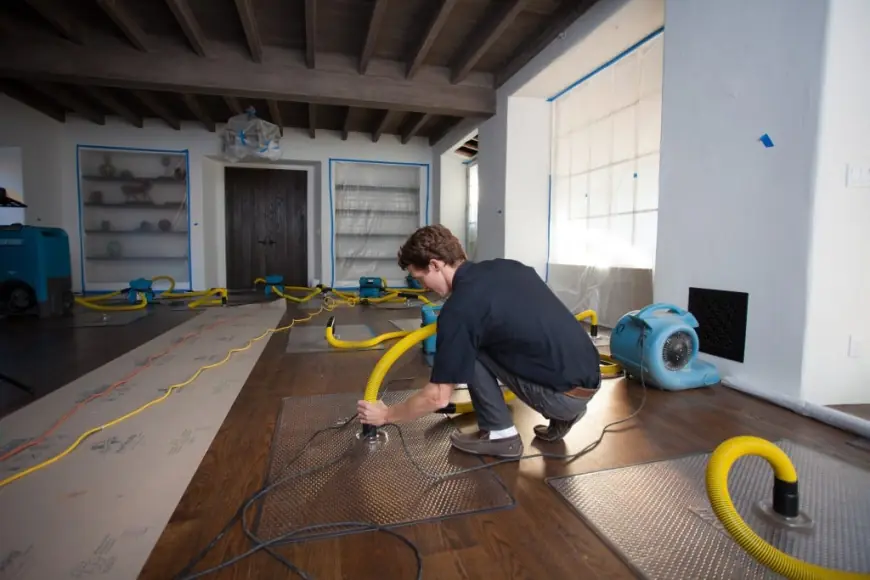Expert Help for Mold: Restoring Safe Indoor Spaces
Commercial mold remediation is a comprehensive process of identifying, containing, removing, and preventing mold growth in commercial buildings. It goes beyond simple surface cleaning by addressing the root cause of the mold and restoring the affected area to a safe and healthy condition. This process is crucial for maintaining a healthy environment for employees and customers and preventing structural damage to the building.

Hiring a reliable Mold Remediation Company is the first and most important step in restoring your property from mold damage. Whether in homes or commercial buildings, mold can pose serious health risks and structural concerns if not dealt with quickly and professionally.
Understanding the Dangers of Mold
Mold is not just an eyesore. It thrives in damp environments and can spread rapidly through walls, ceilings, insulation, and HVAC systems. Mold spores are airborne, making them easy to inhale and difficult to remove without the right equipment and expertise. If left untreated, mold can cause:
-
Allergic reactions
-
Respiratory problems
-
Skin and eye irritation
-
Chronic headaches
-
Worsening asthma symptoms
What Causes Mold to Grow?
Moisture is the main trigger for mold growth. Some common causes include:
-
Leaky pipes or roofing
-
High indoor humidity
-
Poor ventilation
-
Flooding or water intrusion
-
Condensation around windows and walls
Once water enters your property, mold can begin growing in as little as 24–48 hours.
Signs You Might Need Mold Remediation
Not all mold is visible. You might need a mold remediation company if you notice:
-
A persistent musty odor
-
Dark or greenish-black spots on walls or ceilings
-
Warping or bubbling in drywall or flooring
-
Sudden allergy symptoms or breathing issues
-
Previous history of water damage
Early detection is key. The sooner you act, the less damage mold can do.
What Mold Remediation Involves
A professional mold remediation service includes several crucial steps:
1. Inspection and Moisture Mapping
Experts use advanced tools to detect mold growth and identify the source of moisture behind it.
2. Containment of Affected Areas
To prevent mold spores from spreading, affected areas are isolated using plastic sheeting and negative air pressure.
3. Removal of Contaminated Materials
Materials like drywall, carpeting, and insulation may be removed if they’re infested with mold.
4. Air Filtration and Cleaning
Industrial HEPA air scrubbers and vacuums are used to remove airborne spores and clean affected surfaces.
5. Restoration and Prevention
Once the mold is eliminated, damaged areas are repaired, and preventative steps are taken to avoid recurrence.
Why DIY Mold Removal Doesn’t Work
DIY solutions like bleach or mold sprays may mask surface mold temporarily, but they don’t address the root cause. Without proper containment and filtration, you risk:
-
Spreading spores through the air
-
Incomplete removal
-
Personal exposure to harmful contaminants
-
Hidden mold regrowth
Only trained professionals have the tools and knowledge to eliminate mold completely and safely.
Benefits of Hiring a Certified Mold Remediation Company
-
Thorough mold removal
-
Health risk reduction
-
Preventative strategies
-
Restoration of damaged areas
-
Peace of mind and long-term safety
Companies like Instant Restoration bring experience, certified technicians, and advanced equipment to ensure effective remediation from start to finish.
How to Prevent Mold Growth in the Future
Once your property is mold-free, prevention is key to avoiding future outbreaks:
-
Keep humidity levels below 50%
-
Repair leaks immediately
-
Ventilate kitchens, bathrooms, and laundry rooms
-
Use dehumidifiers in basements or crawlspaces
-
Clean and inspect HVAC systems regularly
These practices help maintain a clean, dry, and mold-resistant environment.
Conclusion
Mold isn’t just an inconvenience—it’s a threat to your health, your building, and your peace of mind. A trusted Mold Remediation Company like Instant Restoration ensures that mold is removed completely and won’t return. Don’t let mold compromise your indoor air quality or your property’s value. Address it early, and do it right with professional help.
FAQs
1. Can mold come back after remediation?
Yes, if moisture problems aren't fixed. A good remediation company also addresses the source.
2. How long does mold remediation take?
Typically 1–5 days depending on the extent of the mold and size of the property.
3. Will homeowners insurance cover mold removal?
It depends on the cause. If the mold results from a covered water damage claim, your policy might cover it.
4. Can mold affect pets?
Absolutely. Mold spores can impact pets just like humans, especially those with allergies or asthma.
5. Is mold always visible?
No. Mold often grows behind walls, under floors, or in hidden areas. A professional inspection can confirm it.
What's Your Reaction?
 Like
0
Like
0
 Dislike
0
Dislike
0
 Love
0
Love
0
 Funny
0
Funny
0
 Angry
0
Angry
0
 Sad
0
Sad
0
 Wow
0
Wow
0



















































